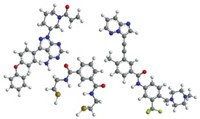Advertisement
Grab your lab coat. Let's get started
Welcome!
Welcome!
Create an account below to get 6 C&EN articles per month, receive newsletters and more - all free.
It seems this is your first time logging in online. Please enter the following information to continue.
As an ACS member you automatically get access to this site. All we need is few more details to create your reading experience.
Not you? Sign in with a different account.
Not you? Sign in with a different account.
ERROR 1
ERROR 1
ERROR 2
ERROR 2
ERROR 2
ERROR 2
ERROR 2
Password and Confirm password must match.
If you have an ACS member number, please enter it here so we can link this account to your membership. (optional)
ERROR 2
ACS values your privacy. By submitting your information, you are gaining access to C&EN and subscribing to our weekly newsletter. We use the information you provide to make your reading experience better, and we will never sell your data to third party members.
Pharmaceuticals
Rethinking A Renin Inhibitor
Case study #3: Vitae turns to Solvias for a new synthetic route as well as Phase II clinical production
by Rick Mullin
March 21, 2011
| A version of this story appeared in
Volume 89, Issue 12

In 2009, as its lead drug candidate completed Phase I clinical trials as a kidney disease treatment, Vitae Pharmaceuticals decided to change its manufacturing game plan. The Fort Washington, Pa.-based computational drug discovery firm had earlier enlisted Solvias to help design the drug’s final production steps. Hoping to reduce costs, it entrusted Solvias to overhaul how the starting materials were made as well.
Solvias, a Swiss contract services firm, was making changes of its own at the time. The company was in the midst of opening a kilogram-scale facility that produces pharmaceutical chemicals at current Good Manufacturing Practice standards. Its goal was to add early-stage manufacturing to the process design and analytical services it offered drug companies.
COVER STORY
Rethinking A Renin Inhibitor
By adding cGMP manufacturing to its menu, Solvias was aiming to establish the proverbial one-stop shop for early drug development. Vitae executives liked what they saw and decided they would hire Solvias for yet a third task: production of the drug’s active pharmaceutical ingredient (API) for future clinical trials.
With the expanded contract, Vitae became the second customer to take advantage of Solvias’ new manufacturing capabilities. The deal illustrated how the service-bundling concept serves to promote Solvias’ core expertise in process design.
Solvias began work on a new synthesis of the starting materials at the end of the Phase I clinical trials. At that time, the drug, called VTP-27999, was being manufactured by Carbogen Amcis, another Swiss firm, with starting materials from a Chinese supplier. Vitae is now moving forward with Phase II production incorporating new chemistry from Solvias that cuts the number of steps in its synthesis of the starting materials roughly in half.
VTP-27999 is an orally available renin inhibitor with four chiral centers. The molecule is as complex as its target. Renin production is the first and rate-limiting step in the renin-angiotensin system, the primary biochemical pathway for regulating blood volume, arterial pressure, and vascular function. Renin affects critical organs—including the heart, kidney, and brain—at a tissue level. Tekturna, a Novartis drug for hypertension, is the only other renin inhibitor on the market.
According to David A. Claremon, vice president of chemistry at Vitae, controlling manufacturing costs is crucial, given the competitiveness of the therapeutic markets that a renin inhibitor might enter. For example, Vitae may also develop VTP-27999 as a hypertension drug, a market in which it would go up against low-cost alternatives. He says Solvias has pushed the compound in the right direction, arriving at elegant chemistry that significantly cuts the cost of production.
Solvias’ initial involvement was in optimizing the final synthetic steps, Claremon says. “We started with them in 2008 on scouting out catalyst routes and crystallization conditions for API production. That was starting from the back end of the synthesis, getting a suitable salt for the API, working on the three-step manufacturing process. Then we got them involved in identifying the routes to making the two starting materials.”
When Vitae learned of Solvias’ new kilo lab, it began calculating the advantages of having the firm that designed the process also manufacture the clinical materials. “They would be able to provide a process well on its way to being a commercial process,” Claremon says. “And that’s what we are aiming for.”
Carbogen manufactured the API for initial clinical studies using starting materials synthesized via traditional medicinal chemistry, Claremon recalls. “We also supplied these materials to Solvias, which began a second cGMP campaign,” he says. “But by this time, they were also developing methods to make the two components using asymmetric chiral catalysis.”
The molecules involved are a 3-substituted piperidine ring and a 3-substituted pyran ring. According to Claremon, the Solvias process induces chirality in racemic starting materials via asymmetric hydrogenation. The process moves forward with two molecules, each with a pair of chiral centers. “The possible number of diastereoisomers is 24, if we proceed randomly,” he says. “But we control all the stereochemistry to give us a single enantiomer and diastereoisomer at the end of the process. No resolution is required in any of the work Solvias has identified for us. There is no waste associated with having materials to throw away from the resolution.”
Michael Quirmbach, vice president for U.S. business development at Solvias, says the firm is familiar with the complexities of renin inhibitor chemistry, having developed a scalable route for Tekturna, the Novartis drug. “The molecules are completely different,” he says. “But they are still targeting the enzyme renin. These are very complex molecules.”
Quirmbach describes the initial process for making the starting materials as “textbook chemistry.” He adds, “It was good, but it was long.” Solvias went to work on developing the chiral centers of the starting materials and the solid-state characterization of the API. Initial cGMP runs have been completed, he says.
Adding cGMP production to its process development services is a natural evolution for Solvias, Quirmbach says. “Prior to offering cGMP kilo lab services, we had been focusing on early-stage process development and supplying non-cGMP toxicology material,” he explains. “Companies had been coming to us with challenging molecules for our process development and solid-state capabilities. We have 150 analytical chemists, with everything done in-house.” Solvias is counting on its strength in process chemistry to boost its entry into manufacturing, an area in which many of its competitors have long played.
At the same time, Solvias will continue to partner with other manufacturers to provide commercial-scale API production based on processes it develops. The new kilo lab has a capacity of about 20 kg. “We will be focusing on development, proof of concept, and first production for clinical trials,” Quirmbach says. “Once you have a good procedure available, a lot of other companies can do the manufacturing. The key is to have the development expertise and integrative project management skills.”
Vitae, as a venture-backed drug discovery firm that is dependent on contractors for a range of chemistry and manufacturing services, sees advantages to the one-stop shop offered by Solvias, Claremon explains. “Solvias has incredible in-house expertise in developing the means of doing chirally catalyzed chemistry,” he says. “They have automated equipment and the catalysts in hand. There aren’t many groups in the world who have all that, as well as analytical support and automated crystallization.
“This was an important one,” Quirmbach acknowledges about the Vitae contract. “Vitae was only our second customer at the time for these bundled services. It was important to find customers that believe we have the right qualifications and can deliver on single-source services for early drug development.”
Solvias currently has about 15 customers paying for bundled services, including manufacturing.




Join the conversation
Contact the reporter
Submit a Letter to the Editor for publication
Engage with us on Twitter